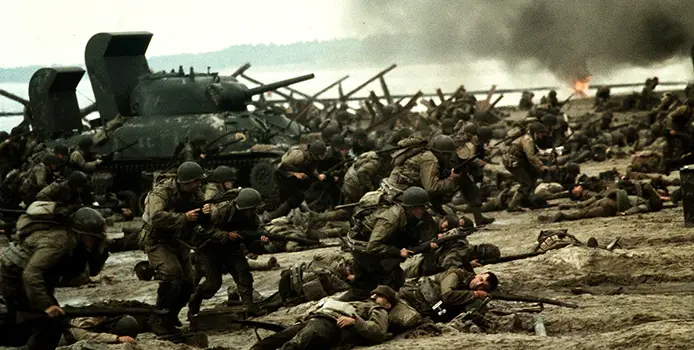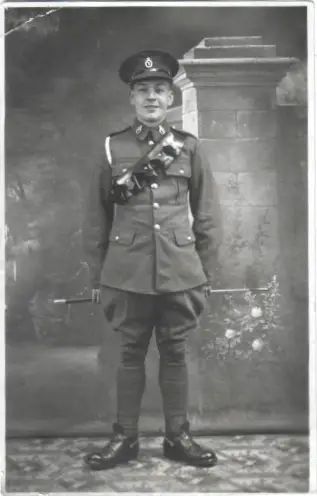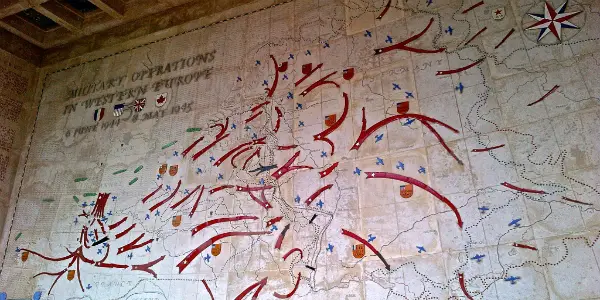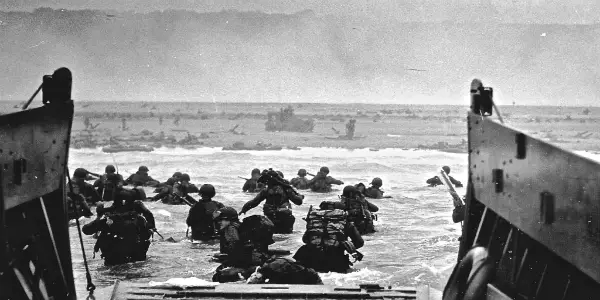A Trip to Normandy and SAVING PRIVATE RYAN

I'm a film buff from South East England. I run…
I first saw Steven Spielberg’s Saving Private Ryan in the early 2000s; it was a VHS copy playing on a big old JVC television that had a similar depth to a Toyota Aygo. I have since seen Saving Private Ryan a large number of times, but my reaction to its first 25 minutes remains unchanged, a reaction of shock, recoil and deep admiration for the people who executed this excellent, transformative piece of filmmaking.
My knowledge of WW2 was minimal at this time, but I roughly knew the basics. I had long known that the baddie was a loud man with a funny moustache that resembled a paintbrush (my father would often place one over his mouth like a second-rate Charlie Chaplin). So familiar was I with Hitler’s appearance that, at the age of 6 or 7, I drew pictures of Hitler being killed spectacularly by my maternal grandfather surrounded by his proud, cheering comrades. I was vaguely aware that Hitler committed suicide in reality, but I chose to ignore this and, long before Tarantino did, created an alternate history in which my grandfather, Sergeant George Rice, singularly killed Adolf Hitler… I thought the premise was entirely plausible.
My grandfather: Sergeant George Rice
The truth is that Sergeant Rice was captured in Greece during the Battle of Kalamata on April 28th, 1941. He was moved from POW camp to POW camp, spending a lengthy amount of time in Stalag 383 in Hohenfels, Bavaria; he was never able to blast the Fuhrer away with his Lee Enfield like I depicted in such detail.

George was around 5 ft 6, of muscular build and while he usually displayed a jovial temperament, he could also get very cross indeed. As you can imagine, a frugal diet of potatoes, a myriad of long monotonous days, regular bouts of crabs and being incessantly ordered to ‘Heil Hitler!’ can test a man’s patience, and it certainly tested George’s. On what must have been a bad day, an officious German barked “Heil Hitler!” at George; the men around him must have gasped when he replied “Heil Churchill!”, the German responded by hitting him with the butt of his rifle, knocking teeth out.
This wasn’t his only story of rebellion, he also had a Steve McQueen moment. To call it a McQueen moment may again be embellishing reality somewhat; there were no motorbikes or elaborate underground tunnels, George’s attempt for liberation instead saw him running away from his farming duty and hiding desperately, and rather amusingly, in a chicken shed, where he was soon found and punished with solitary confinement. After four years of imprisonment, George was liberated by the Americans on 22nd April 1945 and eventually flown to Paris in a Lancaster bomber, spending what must have been an incredible night in the French capital.
While I have always been interested in the Second World War, the past year or two has seen my interest burgeon into real fascination. This compelled me to finally visit the Normandy beaches, the invasion of which I had seen depicted so starkly in Saving Private Ryan.
Embarrassing toll booths
It was my first time driving in Europe, despite the inevitable nerves I was surprised by how quickly I became accustomed to it. I drove from Calais to Caen and back on delightfully sparse roads with no ‘variable speed limits’ and persecutory speed cameras. The drive wasn’t without its obstacles though. The Allies had mud, dense woodland and of course intense combat to deal with – I had tollbooths that were damn expensive and discombobulating to an excruciating degree.
One of the booths (which are often machines rather than humans), gave me a ticket that I assumed was to be inserted in the next tollbooth in a similar fashion to a car park ticket. When I arrived at that next tollbooth and entered it into the slot, the ticket just hanged there limply, it clearly didn’t fit. I futilely tried again half a dozen times, acutely aware of the growing line of cars behind me, the occupants of which bearing expressions of increasing exasperation at this stupid roast beef in their way. It hadn’t entered my head that the slot, which had ‘CARTES’ written above it, was for credit/debit cards. I eventually realised this but only after experiencing deep, almost harrowing embarrassment. I hope this story will prevent others experiencing such a sense of utter helplessness in a foreign country.
I arrived at Caen in the early evening, quickly checking in to my hotel and sprawling myself across the bed to stretch my stiff, aching body. Whilst walking around the city in the pursuit of some dinner, I envisioned the footage of Caen as a crumbling battleground, aware that the devastation of bombing and fighting destroyed the majority of the pre-war, middle-age architecture.

The next day I went to the Overlord Museum just down the road from Omaha beach. It had a wide array of weapons, vehicles, uniforms and various other artefacts on display, all of which were assisted by plenty of information to consume. It was, however, trumped by the Memorial of Caen, which offers a foot-achingly comprehensive history of the war, its origins and its consequences.
As I approached the beautiful American Cemetery above Omaha Beach, I instantly recognised my surroundings, the trees particularly. I realised I was at the same memorial that we see at the very beginning and end of Saving Private Ryan, scenes I had erroneously believed to have been filmed in Arlington Cemetery in Virginia. I stood amongst the scores of attractive white marble crosses arranged meticulously in long diagonal lines, oddly moved by the scope and dignity of the place. After this I marvelled at the striking battle maps, pictured below.

I then descended the steps and emerged from an overgrown, leafy pathway onto Omaha Beach. Despite the knowledge of what happened there and Saving Private Ryan’s jarring recreation, the great sandy stretch certainly didn’t feel like the site of an estimated 2000 casualties, making Omaha the bloodiest of the five beaches on 6 June, 1944. The history of the region was very much alive, with restaurants and plenty of tourist shops adorned with the flags of the United Kingdom, United States and Canada. I also noticed street names such as ‘Avenue de la Libération’ in Caen. The most touching example was simply ‘Thank you’ written into the sand of Omaha Beach, something that I’m sure was replicated across Utah, Juno, Gold and Sword beaches.


Saving Private Ryan
Saving Private Ryan is technically excellent, it achieved what very few films do – it set a new benchmark. The film’s harsh aesthetic, desaturated colour palette and shaky camera work has been emulated many times, Ryan’s influence can be seen in films from We Were Soldiers and Rambo to Black Hawk Down and Fury. Although there have been some decent efforts, I am yet to see a film that equals let alone surpasses the beginning 25 minutes, the final battle in the fictional French town of Ramelle and everything in between.
The film follows the 2nd Ranger Battalion, the salient characters of which including Captain John Miller (Tom Hanks), the affable yet authoritative leader; Sergeant Horvath (Tom Sizemore), the platoon’s second in command; Private Jackson (Barry Pepper), a stylishly ultra- accurate, cross kissing sniper from the bible belt; Private Reiben (Edward Burns), an incendiary man from Brooklyn; Private Mellish (Adam Goldberg), a Jew who relishes informing German captives of his heritage and T5 Grade Timothy Upham (Jeremy Davies), a very timid man who proves wholly unsuited to war. The men’s mission is to locate and send home Private James Ryan (Matt Damon) on the compassionate orders of Chief of Staff George Marshall, who has been informed that Ryan’s three brothers have all died in combat, their mother receiving the three awful telegrams simultaneously.
“You wanna explain the math of this to me? I mean, where’s the sense of riskin’ the lives of the eight of us to save one guy?” says the argumentative Private Reiben. He addresses what I’m sure many viewers were wondering – is this premise plausible? Although inspired by and probably keen to emulate Lincoln’s Bixby letter, would George Marshall have really possessed such compassion during a state of total war? It’s interesting to note that screenwriter Robert Rodat developed the idea after reading a monument in Putney Corners, New Hampshire that listed the names of eight brothers who died during the American Civil War.
Unlike Brad Pitt in the recent Fury, Tom Hanks gives the performance of an everyday man, a middle-class secondary school teacher thrust into an extraordinary situation. Hanks’s character Captain Miller reminds you of what is now the unthinkable idea of conscription, reminds you of how civilians with little or no prior interest, ability or training in the army were mobilised to kill and conquer. However, there’s not much to be found outside of Captain Miller in terms of characterisation; Miller’s men are quite flat and unremarkable apart from Private Jackson, whose ultra-accuracy is displayed with a stylish flair that’s out of character in a film with violence that is appropriately ugly. Jackson is also a good ol’ boy, a self-righteous bible spouting stock character who was recently emulated by Shia LaBeouf as ‘Boyd ‘Bible’ Swan’ in Fury.
What I also found slightly troubling was the construction of the Germans, it was crudely one-sided. Of the countless German troops we see in the film, the only one that is given any depth, ‘Steamboat Willie’ (Joerg Stadler), is shown to be a horribly callous backstabber. Some may argue rather tenuously that he was just a soldier doing his duty in the context of total war, but I think it’s clear Spielberg wants you to hate him. The narrative arcs of ‘Willie’ and Upham (the coward of the platoon) intertwine, climaxing in a scene that I think is ethically dubious.

Despite both narrative and character development being somewhat thinly drawn, they’re not that bad and, crucially, not the centre of the film. The film’s great accomplishment lies in its seminal depiction of warfare. Cinematographer Janusz Kaminski is to be commended for his raw, grisly aesthetic and his perfectly judged use of erratic camera movement, a style that has been messily emulated to nausea-inducing effect far too many times.
Many, myself included, put the emphasis on the film’s opening depiction of the landing on Omaha Beach. However, the film has many other memorable instances of warfare, after all, battle comprises much of the film’s running time.
One moment that sticks in my head is the men’s surprise encounter with a group of Germans who are revealed when a wall is accidentally knocked down. The encounter inevitably ends with a torrent of gunfire, and when the frenzied chatter of the guns and the shattering of glass, brick and wood ends, the long, agonised moans of men in their death throes begin. Saving Private Ryan is a film that shows the consequences of a bullet wound.
Veterans’ perspectives
Like many others have, I could praise endlessly the new level of gripping realist cinema that Ryan introduced to viewers; however, almost all of this commendation is being delivered by people who have never experienced battle. How do we know what a battle truly looks and feels like? The majority of what I witnessed seemed realistic to me, but I can’t offer solid corroboration as I stepped foot on Omaha Beach 70 years too late. Surely the ultimate endorsement and affirmation for Saving Private Ryan is from the people who have experienced war, particularly the Second World War and the D-Day landings.
Written in the Florida Times Union on 15th August 1998 was an account of D-Day veterans ‘enduring’ Saving Private Ryan. This included Bill Faust, 78, who was accompanied in the theatre by only one other as the rest of his North Florida D-Day veterans’ group walked out – “I should have never gone to see that damn movie,” Faust said, “In my mind, most of the details of D-Day were gone; all this did was bring them back… it’s better to keep them tucked away where they don’t bother you.”
The article continues –
“Vietnam veteran Ed Kelly, 57, of Ferdandina Beach, wishes he hadn’t ventured into Saving Private Ryan. He left before the opening scene was over. The realism, the sounds of screaming soldiers, were such poignant reminders. “I just couldn’t handle it,” Kelly said. “The kid holding his guts; I had seen that in Vietnam. That was it for me. I got up and walked out. It was the closest thing to the horrors of real combat that I have ever seen. There was no glossing over it.” “
There was also Jerry Markham, 79, who walked out of the theatre “impressed and depressed, amazed but saddened by the realism of the sights and sounds, especially the instant deaths after the landing craft ramps were lowered.” Markham was a Navy chief petty officer on a demolitions team on D-Day and saw his commanding officer die in this horribly instantaneous manner – “That scene broke me up… that was how it happened. Bodies were flying everywhere… I wouldn’t recommend it for young children, but anyone 14, 15 or older should see it… they should start learning about how horrible war is.”
I think all of this speaks volumes for Saving Private Ryan’s credibility.
What kind of impact did Saving Private Ryan on you? Would you want to visit Normandy, to explore where the Second World War took place? Share your thoughts below.
(top image source: DreamWorks Pictures)
Does content like this matter to you?
Become a Member and support film journalism. Unlock access to all of Film Inquiry`s great articles. Join a community of like-minded readers who are passionate about cinema - get access to our private members Network, give back to independent filmmakers, and more.
I'm a film buff from South East England. I run Hawkensian.com, which comprises mostly film reviews but also various opinion pieces on history and politics.













